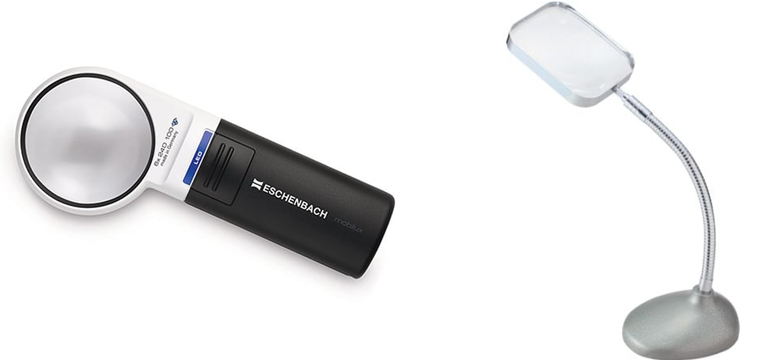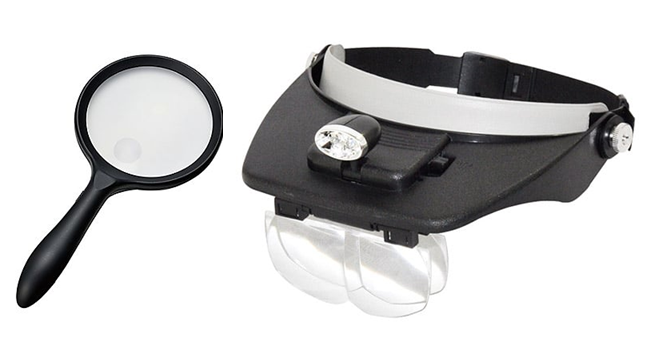
1/ Introduction
A magnifying glass is a single convex lens, typically mounted in a frame with a handle, that produces an enlarged virtual image of an object when viewed through it. It leverages basic refraction principles to bend light rays and present a magnified view, making it indispensable in applications ranging from casual inspection to precision metrology.
2/ Optical Principles
The core function of a magnifying glass arises from the thin-lens equation and angular magnification:
When an object is placed within the focal length, the lens creates a virtual, upright, and magnified image that the observer’s eye can focus on comfortably.
3/ Lens Materials and Coatings
Uncoated glass exhibits Fresnel reflections (~4% loss per surface), so modern magnifying glasses incorporate:
- Crown glass (BK7) or flint glass for high optical quality.
- Acrylic or polycarbonate for lightweight, shatter-resistant lenses.
- Multi-layer anti-reflection coatings (MgF₂ or advanced stacks) to minimize glare and boost transmission above 98%.
- Scratch-resistant coatings for durability in industrial environments.
4/ Lens Geometry and Aberration Control
|
Lens Type |
Geometry |
Aberration Profile |
Typical Use Cases |
|---|---|---|---|
|
Plano-convex |
One flat, one convex |
Moderate spherical aberration |
Low-cost, general purpose |
|
Bi-convex |
Two convex surfaces |
Symmetric aberrations |
Balanced magnification |
|
Aspheric |
One or both aspheric |
Minimized spherical aberration |
High-precision inspection |
Advanced magnifiers may employ achromatic doublets or aspheric surfaces to correct chromatic and spherical aberrations, respectively, producing sharper images across the field.
5/ Mechanical and Ergonomic Design
A complete magnifying glass assembly often includes:
- Rigid frame materials (aluminum alloys, engineered plastics) for stability.
- Ergonomic handles or pistol grips to reduce hand fatigue under extended use.
- Focusing mechanism (rack-and-pinion or sliding barrel) for fine adjustment of object distance.
- Integrated reticles or measurement scales for quantitative readings.

6/ Manufacturing Processes
- Lens Blanks: cast or molded to near-net shape.
- Grinding & Polishing: diamond-tool or pitch laps shape and finish surfaces to λ/4 or better.
- Cleaning & Coating: precision cleaning precedes vacuum deposition of AR coatings.
- Mounting: lens is secured in precision-tolerance housings to preserve centering and minimize tilt.
Quality control uses interferometry to verify surface form and spectrophotometry to confirm transmission.
7/ Standards and Calibration
- ISO 10110: Optical drawing and tolerances for lens elements.
- ISO 9343: Test methods for the measurement of magnification in magnifying glasses.
- Calibration protocols may use NIST-traceable reticle targets and compare against certified roughness standards (ISO 25178) when inspecting surface profiles.
8/ Applications in Surface Roughness Measurement and Material Inspection
- Visual Roughness Estimation: magnification 10X - 50X with calibrated reticle allows rapid Ra and Rz approximation.
- Defect Detection: identification of micro-cracks, pits, and inclusions on machined parts or coatings.
- Pre-Metrology Screening: quick go/no-go assessment before engaging contact profilometers or 3D optical scanners.
Practical workflow often pairs a handheld magnifier with a smartphone-mounted digital camera for image capture and software-based analysis.
9/ Digital and Hybrid Magnifiers
Recent developments integrate CMOS sensors, LED illumination, and wireless connectivity:
- Real-time image enhancement (edge detection, contrast stretching).
- On-device measurement tools for distance, angle, and area.
- Data logging and reporting features for quality management systems.
These systems blur the line between traditional optics and digital microscopy, offering portable metrology in the field.
10/ Future Trends
- Adaptive Optics: active correction of environmental distortions.
- Micro-electromechanical Systems (MEMS): variable focus lenses without mechanical movement.
- Augmented Reality Overlays: live annotation of observed features in eyewear form factors.
By merging advanced materials, precision manufacturing, and digital processing, the humble magnifying glass continues evolving into a versatile tool for modern inspection and measurement.
11/ Application of the Magnifying Glass in Surface Roughness Measurement and Material Quality Inspection
11.1/ Introduction
Surface roughness describes the fine irregularities on a material’s exterior that result from machining, finishing, or wear. Precise control of these irregularities is critical for product performance, fit, and longevity. While high-end profilometers and 3D scanners deliver quantitative roughness data, handheld magnifying glasses remain invaluable for rapid visual assessment and initial quality screening.
11.2/ Role of the Magnifying Glass in Surface Roughness Assessment
A simple magnifying glass offers 10X - 50X magnification, enabling technicians to:
- Visually resolve peaks and valleys on machined or coated surfaces
- Detect scratches, micro-cracks, pits, and inclusions that compromise integrity
- Perform quick go/no-go evaluations before deploying more complex metrology tools
- Aid in routine in-process checks on the factory floor without elaborate setup
11.3/ Visual Measurement Techniques with Reticles
When equipped with an etched reticle scale (e.g., 0.1 mm divisions), a magnifying glass can approximate basic roughness parameters. A typical procedure is:
- Secure the sample on a stable, illuminated stage to eliminate movement and shadows.
- Position the lens so that the virtual image of the surface is crisply focused at the operator’s near point (≈ 25 cm).
- Count the number of visible peaks or valleys across a known reticle span to estimate Ra (arithmetical mean roughness) or Rz (average maximum height).
- Record observations or capture images with an attached camera for subsequent digital analysis or documentation.
11.4/ Integration with Digital Imaging and Software Analysis
Modern workflows often combine a magnifier with smartphone or USB-camera modules. This hybrid approach delivers:
- Real-time image capture with adjustable LED illumination
- On-screen measurement tools for distance, angle, and area
- Automated edge detection and contrast enhancement to highlight features
- Data export and traceability for quality records
11.5/ Advantages and Limitations
- Advantages
+ Rapid, low-cost screening directly on the shop floor
+ Portability for field inspections or maintenance checks
+ Minimal training required for basic defect detection
- Limitations
+ Measurement precision depends on operator skill and reticle accuracy
+ Limited to surface features larger than the resolution limit (≈ 10 - 20 µm)
+ Cannot replace calibrated profilometers or 3D scanners for formal certification
11.6/ Practical Considerations for Accurate Inspection
- Use diffuse, uniform lighting (e.g., ring-light or fiber-optic illuminator) to minimize glare and shadows.
- Stabilize the magnifier with a stand or articulating arm when working at higher magnifications.
- Clean optics with lint-free, anti-static wipes to prevent dust-related artefacts.
- Calibrate reticles periodically against certified roughness standards in accordance with ISO 25178.
12/ Conclusion and Outlook
Although simple, the magnifying glass remains a versatile tool for preliminary surface roughness estimation and material defect detection. Its low cost, ease of use, and adaptability to digital capture make it a staple in quality control workflows. Looking ahead, integration with AI-driven image analysis and augmented reality overlays promises to further extend its capability in precision inspection.
Where to buy the most reputable and quality magnifying glass?
QTE Technologies is one of the prestigious companies specializing in providing optical equipment, including magnifying glasses imported from famous optical brands, ensuring high quality and durability. We provide many types of magnifying glasses with diverse designs, sizes and magnifications, suitable for many different uses such as reading, repairing electronic devices, checking jewelry, or using in research.
QTE Technologies is a proud global MRO provider, serving customers in over 180 countries and always striving to ensure a complete and satisfying customer experience. Established in 2010, we offer over 1 million products across every industry and technology. Additionally, you can reach us anytime via 24×7 chat support, phone, WhatsApp or email. Discover what our valued customers have to say about our services on our dedicated review page .
Author of the article: Editorial Board of QTE Technologies (with a solid background in both engineering and creativity - accumulated over 15 years of experience).




